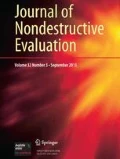Abstract
It is shown in this paper that, in contrast with most other materials, shot-peened nickel-base superalloys exhibit an apparent increase in eddy current conductivity at increasing inspection frequencies, which can be exploited for nondestructive residual stress assessment of subsurface residual stresses. It has been found that the primary reason why nickel-base superalloys, which are often used in the most critical gas-turbine engine components, lend themselves easily for eddy current residual stress assessment lies in their favorable electro-elastic behavior, namely that the parallel stress coefficient of the eddy current conductivity has a large negative value while the normal coefficient is smaller but also negative. As a result, the average stress coefficient is also large and negative, therefore the essentially isotropic compressive plane state of stress produced by most surface treatments causes a significant increase in conductivity parallel to the surface. The exact reason for this unusual behavior is presently unknown, but the role of paramagnetic contributions cannot be excluded, therefore the measured quantity will be referred to as “apparent” eddy current conductivity. Experimental results are presented to demonstrate that the magnitude of the increase in apparent eddy current conductivity correlates well with the initial peening intensity as well as with the remnant residual stress after thermal relaxation.
Similar content being viewed by others
REFERENCES
R. John, J. M. Larsen, D. J. Buchanan, and N. E. Ashbaugh, “Incorporating residual stresses in life prediction of turbine engine disks,” Proceedings from NATO RTO (AVT) Symposium on Monitoring and Management of Gas Turbine Fleets for Extended Life and Reduced Costs, Manchester, UK, 8–11 Oct., 2001.
J. M. Larsen, B. Rasmussen, S. M. Russ, B. Sanbongi, J. Morgan, D. Shaw, J. Jira, D. Johnson, S. LeClaire, M. Blodgett, T. Moran, W. Stange, M. Meininger, and T. Fecke, “The engine rotor life extension (ERLE) initiative and its opportunities to increase life and reduce maintenance costs,” AeroMat Conference, Long Beach, CA, June 12, 2001.
American Society for Metals, Metals Handbook, Vol. 10, X-ray Diffraction Residual Stress Techniques pp. 380–392, 1986, Metals Park, Ohio.
V. Hauk, Structural and Residual Stress Analysis by Nondestructive Methods, pp. 102–112, 1997, Elsevier, Amsterdam.
P. S. Prevéy, in IITT International, pp. 81–93, 1990, Gournay-Sur-Marne, France.
N. Goldfine, “Real-time, quantitative materials characterization using quasistatic spatial mode sensing,” 41st Army Sagamore Conference, August, 1994.
N. Goldfine, D. Clark, and T. Lovett, “Materials characterization using model based meandering winding eddy current testing (MW-ET),” EPRI Topical Workshop: Electromagnetic NDE Applications in the Electric Power Industry, Charlotte, NC, August 21–23, 1995.
F. C. Schoenig, Jr., J. A. Soules, H. Chang, and J. J. DiCillo, “Eddy current measurement of residual stresses induced by shot peening in Titanium Ti-6Al-4V,” Mat. Eval. 53, pp. 22–26 (1995).
N. Goldfine and D. Clark, “Near surface material property profiling for determination of SCC susceptibility,” EPRI Balance-of Plant Heat Exchanger NDE Symposium, Jackson, WY, June 10–12, 1996.
H. Chang, F. C. Schoenig, Jr., and J. A. Soules, “Eddy current offers a powerful tool for investigating residual strees and other metallurgical properties,” Mat. Eval. 57, pp. 1257–1260 (1999).
A Primer on the Alternating Current Potential Difference Technique, pp. 18–21, 1999, Matelect Systems, Nepean, Ontario.
A. I. Lavrentyev, P. A. Stucky, and W. A. Veronesi, in Review of Progress in QNDE, Vol. 19, pp. 1621–1628, 2000, AIP, Melville.
J. M. Fisher, N. Goldfine, and V. Zilberstein, “Cold work quality assessment and fatigue characterization using conformable MWM™ eddy current sensors,” 49th Defense Working Group on NDT, October 31–November 2, 2000.
V. Zilberstein, Y. Sheiretov, A. Washabaugh, Y. Chen, and N. J. Goldfine, in Review of Progress in QNDE, Vol. 20, pp. 985–995, 2001, AIP, Melville.
P. M. Blodgett, C. V. Ukpabi, and P. B. Nagy, “Surface roughness influence on eddy current electrical conductivity measurement,” Mat. Eval. 61, pp. 765–772 (2003).
K. Kalyanasundaram and P. B. Nagy, “A simple numerical model for calculating the apparent loss of eddy current conductivity due to surface roughness,” NDT&E Intern. 37, pp. 47–56 (2004).
M. Blodgett and P. B. Nagy, “Anisotropic grain noise in eddy current inspection of noncubic polycrystalline metals,” Appl. Phys. Lett. 72, pp. 1045–1047 (1998).
M. Blodgett, W. Hassan, and P. B. Nagy, “Theoretical and experimental investigations of the lateral resolution of eddy current imaging,” Mat. Eval. 58, pp. 647–654 (2000).
P. W. Bridgman, The Physics of High Pressure, Ch. IX. Electrical Resistance of Metals and Solids pp. 257–294, 1970, Dover Publications, New York.
N. M. White and J. D. Turner, “Thick-film sensors: Past, present and future,” Meas. Sci. Technol. 8, p. 1–20 (1997).
S. U. Jen, T. C. Wu, and C. H. Liu, “Piezoresistance characteristics of some magnetic and non-magnetic metal films,” J. Magn. Magn. Mat. 256, pp. 54–62 (2003).
E. Uzal, J. C. Moulder, S. Mitra, and J. H. Rose, “Impedance of coils over layered metals with continuously variable conductivity and permeability--Theory and experiment,” J. Appl. Phys. 74, pp. 2076–2089 (1993).
S. J. Norton and J. R. Bowler, “Theory of eddy-current inversion,” J. Appl. Phys. 74, pp. 501–512 (1993).
E. Uzal, J. C. Moulder, and J. H. Rose, “Experimental-determination of the near-surface conductivity profiles of metals from electromagnetic induction (eddy-current) measurements,” Inverse Problems 10, pp. 753–764 (1994).
C. Glorieux, J. Moulder, J. Basart, and J. Thoen, “The determination of electrical conductivity profiles using neural network inversion of multi-frequency eddy-current data,” J. Phys. D: Appl. Phys. 32, pp. 616–622 (1999).
Author information
Authors and Affiliations
Rights and permissions
About this article
Cite this article
Blodgett, M.P., Nagy, P.B. Eddy Current Assessment of Near-Surface Residual Stress in Shot-Peened Nickel-Base Superalloys. Journal of Nondestructive Evaluation 23, 107–123 (2004). https://doi.org/10.1023/B:JONE.0000048866.40648.fe
Issue Date:
DOI: https://doi.org/10.1023/B:JONE.0000048866.40648.fe




